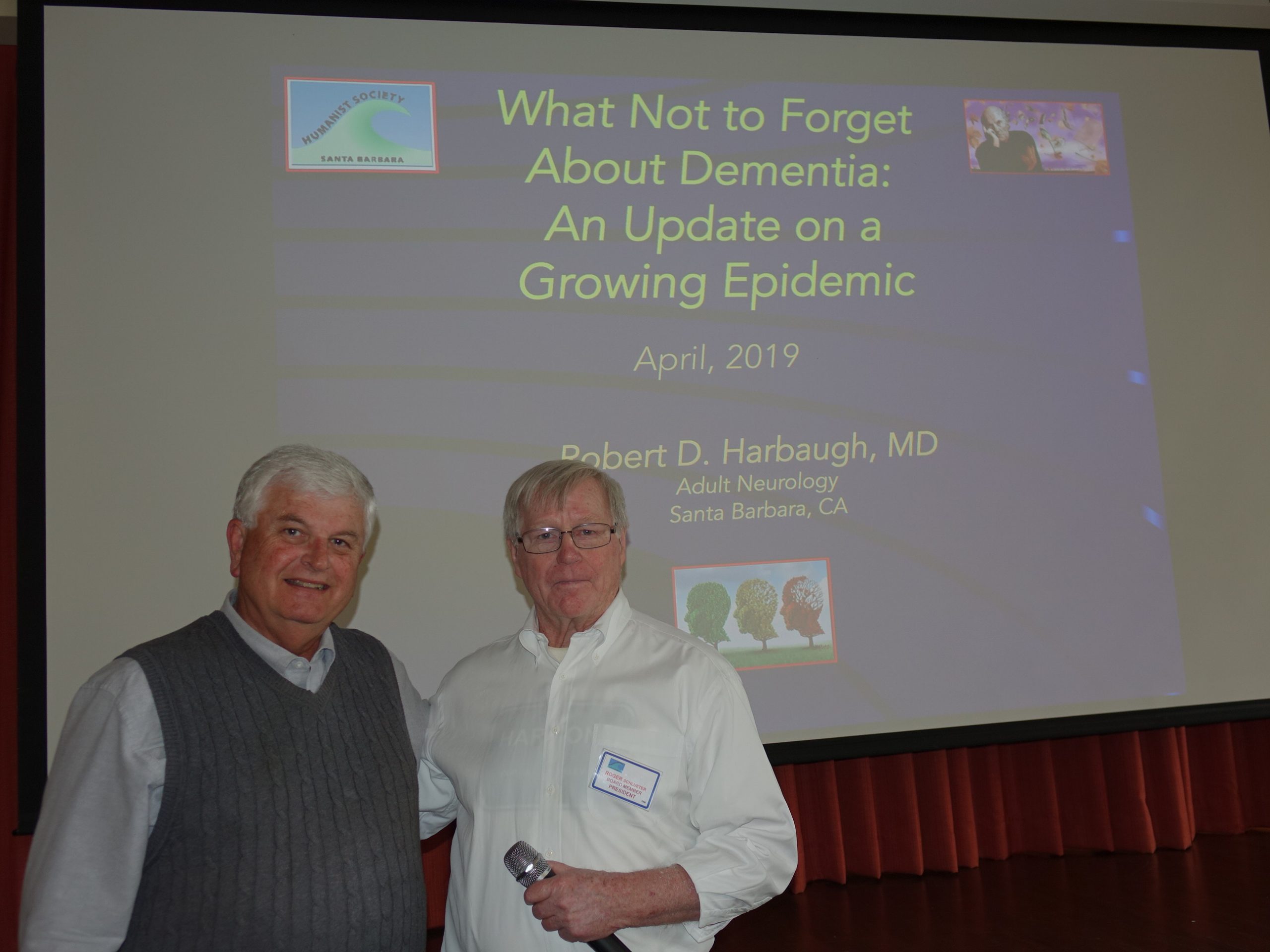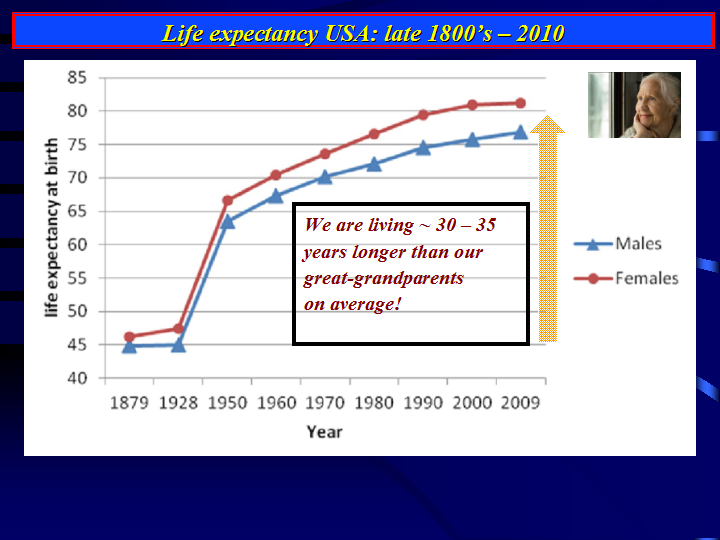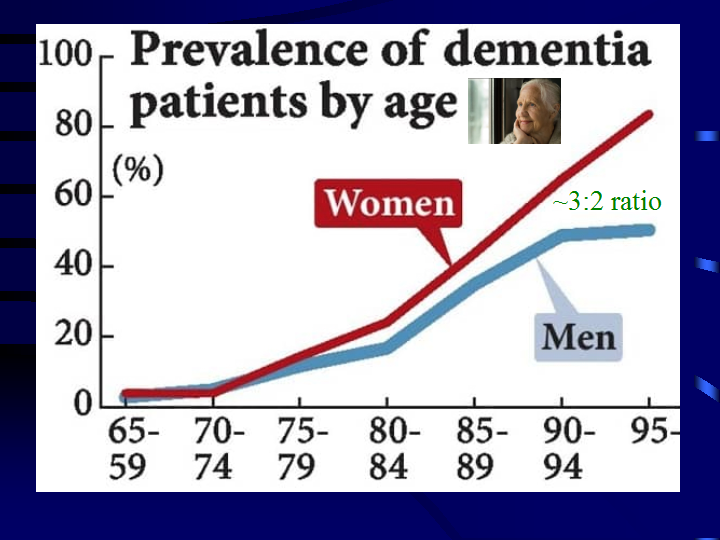What Not To Forget About the Dementia Epidemic

By Robert Bernstein
Dr Harbaugh is “mostly” retired from medical practice but he is very active with educating about Alzheimer’s and other forms of dementia. He recently spoke to the Humanist Society of Santa Barbara to help educate us on the subject. Here are my photos from the event.
Here he posed with Humanist Society president Roger Schlueter before his talk.
Dr Harbaugh was very kind to share his slides with us so that we can peruse them later. Here I have posted them all for this purpose.
Most people raised their hand when asked if they have had close experience with people with dementia and/or they have been a caregiver.
His goal was to cover the most frequently asked questions. Starting with the difference between normal aging versus mild cognitive impairment.
Dementia is the “climate change of medicine” today in terms of scale and impact.
Normal brain aging goes on for decades and is unique to each person. It is modified by task and time. As we age we have to compensate for these changes.
He claims that young people can multitask and that as we age we have to focus on one thing at a time. I will note that several studies have shown that almost no one truly can multitask.
One problem with dementia is that it is hard to get a good baseline measurement. People may have early dementia in baseline studies which contaminates the data.
By the late 80s and early 90s measurable cognitive losses are a part of normal healthy aging. Just as a person this age can’t sprint like a young person.
There is some good news. Wisdom is retained with age and gets better. This is called “Crystallized Intelligence”. Surprisingly, recall gets better with age and is more accurate.
Verbal and language abilities improve along with greater vocabulary.
However, there are declines with age: Fluid Intelligence. The ability to understand and process new and complex information. Recent memories are harder to store and recall. Divided attention becomes difficult. Word retrieval can become more difficult. Unfamiliar problems take longer to solve. And overall cognitive processing gets slower.
Dr Harbaugh is 66 and he is already dealing with these declines.
He showed a graph of rising and falling abilities with age:
Where these ability curves cross is the age when people do their Nobel Prize winning work.
Mild Cognitive Impairment (MCI) is measurable but not disabling. Changes in memory, language, thinking or judgment. It is not a specific disease but a condition.
Few dementias occur suddenly. MCI typically comes about 2 – 5 (but up to 10) years before dementia. Some MCI gets better. It is not specific to Alzheimer’s. But for a critical job like a pilot or surgeon it can be disabling.
MCI can also make a person more susceptible to scammers.
Dementia can take many forms. Not just memory and cognition. It can affect behavior, social cognition and executive function.
A definition of dementia is the inability to live independently. Often the person is blind to their own cognitive loss. One approach to assess whether someone is in the earliest stages of a true dementia would be to ask their spouse/caregiver/immediate family “would you be comfortable leaving this person on his/her own for a week or so, expecting them to remain safe, tend to needed activities of daily living and deal with minor unexpected day to day events in their lives”.
He presented this slide of symptoms and signs

Behavior changes are often the first symptoms. Anxiety and/or depression. A childish view of the world.
Alzheimer’s accounts for about 60% of dementia cases. But there are many others, including Huntington’s, Multiple Sclerosis, Parkinson’s and Lewy Body for example. Over 100 conditions can cause dementia.

It is called the Gray Tsunami and will be a global epidemic by 2050. Age is the main risk factor.

Dementia halves life expectancy. The increase is exponential globally as the world population ages. One new person every three seconds is found to have dementia. The number will double every 20 years. Each needs a caregiver. The cost in the US is already higher than for any other disease. Even small benefits are worth a lot. It would be the 18th largest economy if it were a country!

We are living 30-35 years longer than our grandparents on average. In 1900 TB or pneumonia would be the largest single causes of death. Heart disease and cancer top the list today. But the rates (incidence) of those causes of death are falling.
We now can say the leading cause of dementia is TMB: Too Many Birthdays!
We are living into the susceptible ages for the development of the common dementias and starting to see the effects of very advanced aging, when natural loss of our intellectual capacities are unearthed (90’s – 100’s).
Modern technology, medical innovation, the control of infectious diseases along with a host of other developments has led to dramatic extensions in life expectancy in all parts of the globe.
The prevalance rate of Alzheimer’s dementia for women exceeds that for men by 3:2. It is not known why but researchers are exploring potential reasons.
What is the history? He showed a photo of Dr Alzheimer around 1900. Alzheimer studied people after death. Improved staining techniques allowed better post-mortem observations of brains.

He did an autopsy on a woman named Auguste who was his patient in 1901. This was the first description of the disease. But it lay hidden for 60 years until it was rediscovered.
In 1976 it was discovered that Alzheimer’s was the main cause of dementia. Research was helped by CAT scans which were new and later MRI scans.
The National Institute on Aging was founded at NIH in 1974. The Alzheimer’s Association was founded in the 1980s.
The Baltimore Longitudinal Study of Aging followed individuals for years. When a cohort dies, their brains can be studied which is very helpful for research.
The 1990s gave us the Internet and the opportunity to share data widely.
People appreciate having their disease labeled. This is true for loved ones as well. It allows them to understand what the future holds and what are their treatment options. It allows them to connect with others who are facing the same issues. There are many practical issues: Genetic issues for the family. Safety. Driving. Financial management.
We are inaccurate judges of our own cognitive abilities. Dementia impairs self awareness. As noted above, it helps to ask a spouse or close friend. Even they may not catch it as the changes are slow.
There is a tendency to “renormalize” behavior and think that is just how he/she is. Casual contacts won’t catch the changes.
Mild Behavioral Impairment (MBI) is often not talked about. It can lead to depression, apathy or impulse control problems. A person can get agitated or have odd thoughts or delusions.
Arguing with the person is not helpful. There are meds that can help. Brain tumors and infections can cause similar problems but they come on faster.
One in a million people have Creutzfeldt–Jakob disease which is the human equivalent of “mad cow” disease. A person with this loses control areas of the brain. They may pee on the carpet or commit crimes. But they can also become more creative!
There are 2 million people in the US with Lewy Body disease and another 2 million with Parkinson’s. Together these are the second largest dementia cause and they have similar symptoms.
Contact sports with a high incidence of repetive head injuries (even minor) will have to be curtailed unless there are big rule changes. Head injuries and alcohol are very likely each worse for good brain health than realized in the past. The effect is probably linear with “dose”. Less is better.
For a while it was thought that moderate drinkers are healthier than teetotalers. It seems that research was distorted by the fact that teetotalers may be ill for other reasons. Unfortunately, young people are drinking more.

Dr Harbaugh highly recommends a twelve – fifteen minute office based test of cognition that tests several brain regions. It is good to do serial exams with 6-12 month follow ups.
One popular brief test is the Montreal Cognitive Assessment (MOCA – it is free to use, but there may be a charge to administer)

Why is there no cure for Alzheimer’s or other dementias? The cellular events that lead to brain cell loss and dementia do not seem to occur in other organ systems and are generally not detectable in the blood (however, researchers are exploring this).
The actual “cause” of Alzheimer’s disease (AD) is still unclear at the molecular level, although many of the pathological changes which have been mapped out in detall over the past few decades are well described. We now now that the changes seen in the brain start up to 10 – 15 years before any symptoms are apparent. Exactly how and why the primary pathological changes seen in AD (specifically the accumulation of amyloid plaques and so called tau “tangles”) transpire continues to be assessed and remain debated; what we see after a person dies with AD may reflect the body’s attempt to repair or prevent neural degeneratiion or may be epiphenoma. How these pieces interface and potentially contribute to the disease continue to be explored by many thousands of researchers around the world. Stay tuned!
PET-CT can spot Amyloid beta plaques. Spinal fluid can show them, too.
Diet, exercise and social interaction may help.
Many treatments have been tried, but none have proved effective. Anti-inflammatories do not help. Drugs developed in mice have not worked in human Alzheimer’s to date.

“Supplements” are claimed to help, but they don’t so far. The FDA is cracking down on these claims.
Dr Harbaugh supports the Alzheimer’s Association. He says we need to support more research funding and vote for candidates who will support more research funding.
He trusts information from Pub Med and from NIH. But you should be skeptical of other sources.

He was asked about driving risks. Early MCI is about the same risk as being a teen driver. It might be good to limit driving to daytime and back roads. Uber and Lyft are options for mobility now.
One option is to limit check privileges over $200 and require a second signature. And to limit credit card purchases to a preset, reasonable amount.Perhaps $500. Dementia can lead to pathological gambling and shopping behavior.
Marian asked about the Prevagen ads on TV. There is a cease and desist order from the FDA about their claims of a treatment based on jellyfish. The treatment is a protein. Proteins are digested in the stomach so the claim is not possible.
Here is Dr Harbaugh with Marian

A suggestion was made that presidential candidates be tested for cognitive decline by an independent physician. This came up in the context of presidents Reagan and Trump during the question period.
I will close this article with two additional points. First, there is research indicating that sleep seems important for removing Amyloid Beta. Here is one recent report: https://www.nih.gov/news-
I will also note that we had a recent talk on Alzheimer’s by neuroscientist Lisa Genova. To promote vital information she took an unusual route for a scientist: She wrote a novel! That novel was made into an Oscar winning film “Still Alice”.
Here is my article on her talk.















